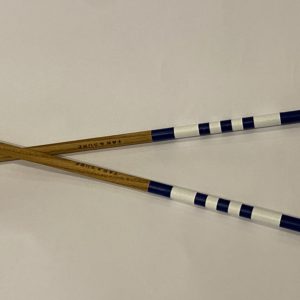Newbie – sand sealer / painting dowels
Hoping someone can advise best practice. I am currently on a project creating hand painted ash dowels at 45” in length and similar diameter to arrows.
I am trying to get the wood to really shine and look amazing finish as well as the paint led ends I am doing. My current method gives me good results but I wanted to ask whether I doing it right or should I be doing another way?
currently:
1. Sanding dowels
2. applying stain
3. using shellac sanding seal.
4. Finely using fine wire wool.
5. Hand painting end
6. using a spar urethene / yacht varnish for a finish.
i do have some danish oil and wondered if I should be using this? These are for external use.
thanks
















Replies
Arrows are normally bare wood with perhaps just the coloured-ring ID markings on them.... but I can't imagine that any sort of finish would spoil their flight characteristics. On the other hand, they will be vulnerable to scratch-damage in use, if finished with a shiny coat of some kind.
More important is: what sort of ash dowell have you employed? If the grain in those 45" lengths runs out, those arrows won't last more than a few flights before snapping. Commercial dowell is not usually straight grained over those sort of lengths, especially in the slimmer sizes.
But perhaps you've made them yourself by carefully riving some straight-grained maiden ash tree trunk with a mini-froe? :-)
Lataxe
Hey Lataxe, thanks - these are actually for use in Golf! :)
I’ve taken inspiration from arrows and how they are made/painted. The dowels have been made on machine.
Ah ......
I have often thought that shootin' golfers with a bow & arrer would make good, if illegal, sport. Of course, I would do it with them arrers that have suckers on the front end. :-)
When I was a lad, 379 years ago, me and my pals would often go to the local golf course to bait the snobs that were the usual habitues of golf courses in those days. (I'm speaking of Blighty rather than Yankland). Those golfers liked to chase small boys from their domain, especially if the small boys had yah-booed at them (which we had). They rarely caught us as they were generally flabbers, from too much time at the 19th hole.
Golf courses can make fine toboggan runs when it snows, mind. Those golfermen didn't like us doing that, either. But they could only shout through the window from that 19th hole, since even half an inch of snow put them off from knocking a wee ball into a hole with a stick. :-)
Lataxe, a trespasser.
Ha ha I’m a fellow brit
It sounds like you have a good finishing routine. I wouldn't switch to Danish oil.
Cheers thank you
When and what is danish oil usually used for?
danish oil (a misleading term) is a blend of oil (usually BLO) and varnish with thinning solvents. It makes a nice wipe-on finish in itself, giving the darkening effect of oil, a good hand feel, and a very thin layer of varnish. You can build it up but it takes a lot of coats. It also comes tinted, so you can add color at the same time.
Also, sometimes when I’ve used the yacht varnish over white paint it tinges yellow - is there a way round this? Should I maybe thin with mineral spirits the varnish or clear coat?
Yacht varnish has "magic" chemicals in it that help it withstand the UV exposure of the great outdoors and make it a little stretchy so it doesn't crack with the frequent temp changes. Thinning it is not generally a good idea. you will just get a lighter yellow and forfeit all the benefits of using yacht varnish. If you are going to do that, you might as well just use varnish or poly.
All varnishes tend to have some degree of amber tint either naturally or in some cases added to make the finish "warmer" and more along the lines of what we expect our finished wood to look like.
Lacquers can provide a clearer finish but aren't always friendly to other finish materials, so test before using, nor will they be as weather resistant or flexible as your yacht varnish.
any oil-based varnish is going to have some amber tint because the color comes from the oil. Water-based varnish can be just as tough, but can be clear. Spar varnish is softer than regular varnish because the boating environment needs flexibility. Its expected to be periodically touched up. No perfect finish.
This forum post is now archived. Commenting has been disabled